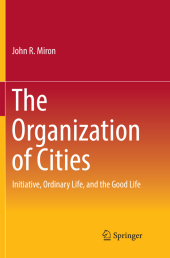 Neuerscheinungen 2018Stand: 2020-02-01 |
Schnellsuche
ISBN/Stichwort/Autor
|
Herderstraße 10
10625 Berlin
Tel.: 030 315 714 16
Fax 030 315 714 14
info@buchspektrum.de |

John R Miron
The Organization of Cities
Initiative, ordinary life, and the good life
Softcover reprint of the original 1st ed. 2017. 2018. lx, 537 S. 12 SW-Abb., 30 Farbabb. 235 mm
Verlag/Jahr: SPRINGER, BERLIN; SPRINGER INTERNATIONAL PUBLISHING 2018
ISBN: 3-319-84318-4 (3319843184)
Neue ISBN: 978-3-319-84318-6 (9783319843186)
Preis und Lieferzeit: Bitte klicken
This book focuses on the relationship between the state and economy in the development of cities. It reviews and reinterprets fundamental theoretical models that explain how the operation of markets in equilibrium shapes the scale and organization of the commercial city in a mixed market economy within a liberal state. These models link markets for the factors of production, markets for investment and fixed capital formation, markets for transportation, and markets for exports in equilibrium both within the urban economy and the rest of the world. In each case, the model explains the urban economy by revealing how assumptions about causes and structures lead to predictions about scale and organization outcomes. By simplifying and contrasting these models, this book proposes another interpretation: that governance and the urban economy are outcomes negotiated by political actors motivated by competing notions of commonwealth and the individual desire for wealth and power. The book grounds its analysis in economic history, explaining the rise of commercial cities and the emergence of the urban economy. It then turns to factors of production, export, and factor markets, introducing and parsing the Mills model, breaking it down into its component parts and creating a series of simpler models that can better explain the significance of each economic assumption. Simplified models are also presented for real estate and fixed capital investment markets, transportation, and land use planning. The book concludes with a discussion of linear programming and the Herbert- Stevens and the Ripper-Varaiya models. A fresh presentation of the theories behind urban economics, this book emphasizes the links between state and economy and challenges the reader to see its theories in a new light. As such, this book will be of interest to scholars, students, and practitioners of economics, public policy, public administration, urban policy, and city and urban planning.
Preface.- Part A. Background Ideas .- Chapter 1. The state, decentralization and entitlement, and the organization of cities.- Chapter 2. State, economy, and city: a reconstruction.- Chapter 3. Explaining the rise of commercial cities. - Part B. The Mills model .- Chapter 4.- A modern perspective on the urban economy: Mills model.- Part C. Export and factor markets.- Chapter 5. A simple model of a oneNindustry town.- Chapter 6. Land for worker accommodation in a one industry ribbon town.- Chapter 7. Land for industry in a one industry ribbon town.- Chapter 8. A simple model of an urban economy with multiple industries.- Chapter 9. Land for worker accommodation in a multi industry ribbon town.- Chapter 10. Land for industry in a multi industry ribbon town.- Chapter 11. Substitution and the urban economy.- Part D. Real estate and fixed capital investment markets.- Chapter 12. Real estate and the urban economy.- Chapter 13. Risk, investment, and the urban economy.- Part E. Transportation, land use planning, and the urban economy.- Chapter 14. Districting in the urban economy.- Chapter 15. Commuting and the urban economy.- Chapter 16. A simple model of land use planning in the urban economy.- Chapter 17. Nuisance, zoning, and the urban economy.- Chapter 18. Transportation planning and the urban economy.- Part F. Synthesis.- Chapter 19. Herbert-Stevens.- Chapter 20. Ripper-Varaiya.- Chapter 21. Conclusion.


